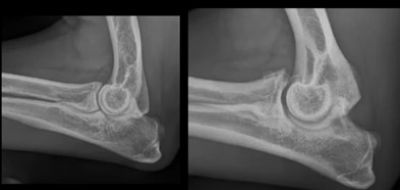
Posted By:
Canine osteoarthritis, a condition echoing the challenges faced by humans in their golden years. Just like us, our furry companions are susceptible to this degenerative joint disease, often encountered in their later stages of life.
Osteoarthritis (OA) is a really common condition we see, and like in people it is more common in older dogs and cats. It is a degenerative joint disease that can cause pain, stiffness, and reduced mobility and can be a really uncomfortable condition for our furry friends. The condition occurs when the cartilage that cushions the joints begins to break down, which in turn leads to inflammation and damage to the joint.
Symptoms of osteoarthritis include limping, stiffness, reluctance to move, difficulty standing up or lying down, and a decreased interest in physical activity. Most commonly we notice these signs after a period of lying down when the joints have stiffened up a bit and symptoms often improve after moving about a bit. There are a number of factors that can contribute to arthritis in dogs including breed, age, and obesity. OA is often diagnosed based on symptoms and age alone but can be confirmed by x-ray. The below image demonstrates the difference between a healthy elbow and one with arthritis. Where the bone has been rubbing together new fragments of bone have been created called osteophytes.
https://www.zoetisus.com/petcare/blog/canine-oa-radiograph-interpretation
Treatment of OA involves managing the symptoms of the disease and providing supportive care. This may include changes to the dog's diet, medications to manage pain and inflammation, and regular exercise to maintain mobility and flexibility.
We are increasingly seeing more and more obesity in our pets and this is a major contributing factor to the development of arthritis. We don’t tend to go off the weight of an animal but use a system called body condition scoring instead which is illustrated below. 5/9 is an ideal condition for your dog and by having your dog at the correct condition you significantly reduce the pressure on their joints reducing the symptoms of arthritis. Changing your dog onto a low calorie diet may help them to reduce their weight.
Even though they may be stiff exercise is still important when managing osteoarthritis. Regular but moderated activity is best, avoiding intermittent “extremes” of exercise to keep the muscles strong to support the affected joints. Swimming is great as this doesn’t put as much pressure through the joints. Exercise can be difficult to maintain in dogs suffering from arthritis as it is uncomfortable for them to walk, in which case we can add in anti-inflammatory and pain relief to help with this such as loxicom and paracetamol. Joint supplements can also be of use to help lubricate the joints and make movement easier.
Making sure your pet has somewhere comfortable and warm to sleep at night also really helps with arthritis. Like us if they’ve slept on a hard floor or in a cold room this can make their joints feel much worse. Providing a memory foam mattress for them to sleep on can help make them much more comfortable.
If you suspect that your dog may be suffering from osteoarthritis, it's important to seek veterinary care as soon as possible. With proper management and care, many dogs with osteoarthritis can continue to live happy and healthy lives.
- Vet Rachel
Whilst on my visits I have been having several discussions...
As our feline friends get older there are a few conditions...
Another winter discussion group season is now behind...
©2024 Shepton Veterinary Group Ltd., All rights reserved.
Privacy Policy • Terms & Conditions • Cookie Policy